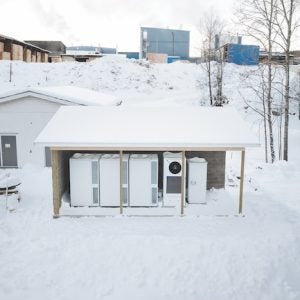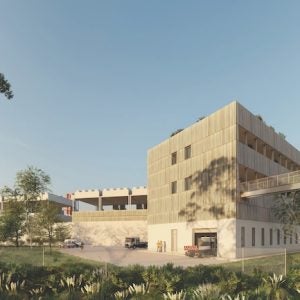SeaGen, described by its developers as the world’s first commercial scale tidal stream system and the world’s largest ever such device by a large margin, is currently located at Harland and Wolff’s shipyard in Belfast, where it was assembled. It is complete and ready for installation, which will be done by Danish contractor A2SEA (a pioneer in the offshore wind sector), using the jack-up barge Jumping Jack recently acquired from Mammoet. It is expected that the drilling of a single hole into the seabed and the installation of the device will take 14 days.

Location of Strangford Lough

Superstructure (right) and cross-arm (left) ready for installation, at Harland & Wolff, Belfast, April 2007

Completed rotor assembly at Harland and Wolff
It has taken some years and a good deal of hard work to get to this point. The twin-turbine (2×600 kWe) SeaGen system, which Marine Current Turbines (MCT) calls a “commercial demonstrator”, builds on experience with the 300 kWe Seaflow device, which was installed off Lynmouth, Devon, UK, in 2003, and before that a 15 kW “proof of concept” machine installed in Loch Linne, Scotland, in 1994, itself an evolution of earlier ideas. Indeed, Peter Fraenkel, principal developer of the MCT technology (and the company’s technical director), can trace his involvement with “water current kinetic energy conversion” back to 1976 (albeit an experimental system using Darrieus type rotors in river currents to provide small amounts of pumping power for irrigation).

SeaGen monopile at Harland and Wolff
The Seaflow system, which employed monopile technology developed by Seacore (now Fugro Seacore), has achieved its full rated power of 300 kW (although it more generally runs at 150-250 kWe) and has successfully demonstrated a rotor efficiency of around 45%, which compares favourably with modern wind turbines. The installation remains unique, according to Peter Fraenkel, “in being the only marine renewable device (tidal or wave) to function in exposed offshore conditions for an extended period.”
Among other things Seaflow, which is due to be decommissioned late 2007/early 2008, has demonstrated that:
• axial flow rotors (well established in the wind sector, of course) are the conversion mechanism of choice;
• the marinised drive train works well, with the gearbox and generator casings providing the water tight housings, and allowing good passive cooling (by the passing current), with typical Seaflow gearbox-oil temperatures at full power being around 60°C;
• the surface breaking monopile with raising and lowering of the power unit for repair and maintenance is effective;
• the system has good structural integrity, including under storm conditions;
• the cost of intervention (using small boats) has been low, although weather windows are, not surprisingly, small in winter; and
• environmental impacts have been small.
The Seaflow project cost around £3.4 million, with 60% coming from the UK government and the EC, and the rest from MCT’s investors and consortium partners, including EDF Energy, BankInvest, Guernsey Electricity and Seacore.
The SeaGen project will cost some £8.5 million, with the UK government meeting 50% of the cost and MCT private investors, EDF, BankInvest, Guernsey Electricity and newcomers, includingTriodos Bank, providing the rest.
MCT has recently secured £7.5 million of new finance, with new investment from Triodos, along with new money from hedge fund AM2 (Bermuda) Ltd and some of the existing shareholders. This additional funding will support future project development, which includes planning for a 10 MW farm off Anglesey, as well as the SeaGen project. MCT believes it is not unrealistic to envisage up to 500 MW of tidal stream generating capacity by 2015.
However, it has taken the four years since Seaflow was first deployed to design and build SeaGen and to secure the necessary environmental and planning consents, which allow the machine to operate in Strangford Lough for up to five years.
Reflecting the special marine environment of Strangford – a particularly sensitive site in environmental terms – MCT has undertaken to carry out a comprehensive environmental monitoring programme during the project, as a condition of receiving consent. This programme, estimated to cost about £2 million (in addition to the £400 000 spent on obtaining the consents themselves), addresses such issues as potential harm to “creatures of the deep”, eg acoustic disturbances to seals.
The environmental monitoring, a complex and elaborate process, which includes the tagging of seals for satellite tracking and determining the movements of porpoises, is overseen by an independent body and managed by environmental consultancy Royal Haskoning, working with universities.

Visualisation of SeaGen installed at Strangford
SeaGen features
The reason SeaGen has two turbines instead of the single turbine used in its predecessor, Seaflow, is that this arrangement captures twice the energy of one rotor at less than twice the cost, which clearly improves the overall economics. The power units are mounted on wing-like extensions either side of the 3 m diameter monopile (see illustration, left).
Each SeaGen rotor, which has full span pitch control to enable it to be reversed through 180 degrees for bidirectional operation when the tide reverses direction, is 16 m in diameter.
The SeaGen rotor design is much more sophisticated than that of Seaflow. Seaflow was linearly optimised to keep construction simple, while SeaGen is fully optimised to achieve the best hydrodynamic shape. The design techniques have been adapted from wind technology, but much bigger forces are generated in water, so a lot of carbon fibre is used in SeaGen.
The rotor has a speed of around 12 rpm and drives the generator via a gearbox.
The three-stage gearbox (two planetary and one spur) is of an innovative design developed by Orbital 2 and manufactured by Wikov. It is very compact and light (12.2t) for its torque rating (433 kNm), with a speed-increasing ratio of 69.8:1. A particularly innovative feature is that the first planetary stage (pictured, top right) uses eight planets rather that the usual three. The result is that the torque is spread over many more teeth, allowing them to be much smaller (a concept which is also potentially applicable in the wind business).
SeaGen is equipped with a naval-architect-designed pile-top superstructure moulded from glass reinforced composite. This structure plus the interior of the pile accommodates the power electronics and transformer, together with the hydraulics for lifting and lowering the cross-arm and twin rotors. The interior is climate controlled, with a heat exchanger in the pile below water level. At full power about 80 kW of waste heat needs to be dissipated from electrical ancillary components.

First planetary stage of gearbox
Future plans
In terms of future development, MCT believes the way forward is to deploy horizontal arrays of smaller or bigger rotors, although the possibilities for obtaining more power by dramatically increasing rotor diameter are limited by water depths, as well as by the stuctural loading of the blades and the ability to handle very high levels of torque. This means that future capacity increases will be mainly achieved by “growing” the system sideways. Six 8 m rotors would produce about 660 kW, while six 24 m rotors would deliver over 8 MW.
MCT is now looking at a horizontal array structure of the kind shown in the illustration below, which the company calls “second generation technology.”
Life cycle unit costs are projected to reduce with successive projects, as shown Table 1.
Another indicator of cost effectiveness is kW per tonne of equipment. In Table 2 MCT devices are compared with wave energy systems and with offshore wind.

Possible second generation system: horizontal array structure
| Tidal stream technology – the state of the art |
p-br-having-learnt-the-hard-way-about-what-it-takes-to-get-a-1-2-mwe-tidal-stream-machine-into-the-water-at-strangford-lough-peter-fraenkel-of-mct-has-been-looking-with-some-interest-at-recent-high-profile-claims-from-developers-of-competing-devices-about-how-close-they-are-to-commercial-realisation-br-he-emphasises-the-lengthy-provenance-behind-mct-s-technology-enabling-his-company-to-arrive-at-a-real-megawatt-sized-system-which-he-believes-is-3-5-years-ahead-of-the-competition-he-is-concerne More Relevant |






